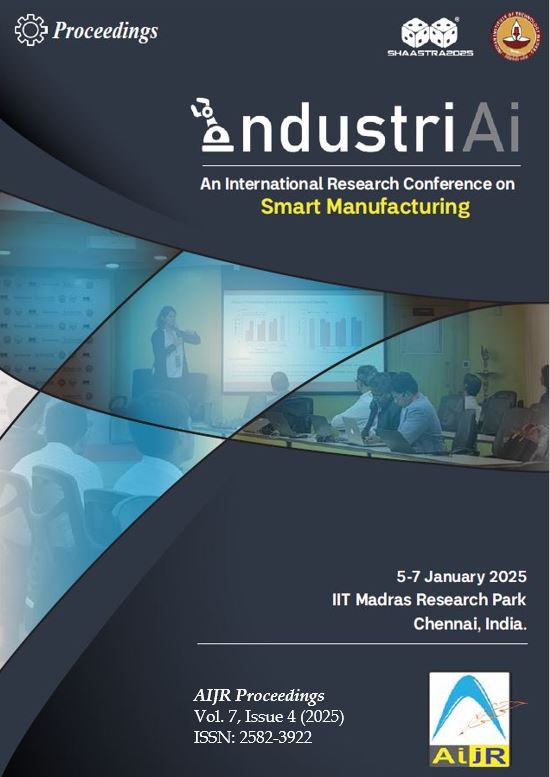AI-driven Special Agricultural Technology for Pest Management with the help of Polymeric Filament in an Aerial Vehicle
DOI:
https://doi.org/10.21467/proceedings.7.4.1Keywords:
Agriculture, Pest infestation, Polyphenylene sulfideAbstract
In a tropical country like India, its rich heritage and culture were tied to agriculture. Agriculture contributed significantly to the country’s GDP. However, with an increase in production, it became difficult to maintain the crop quality. In the era of smart technology, the addition of innovation in our daily tasks has helped reduce the load in many ways. Considering farming as a business where the demand and supply almost drew an equal bar with demand being slightly higher, many crops were destroyed, mostly due to pest infestation. To maintain the crop quality as well as the production, a raptor with a polymeric filament propulsion mechanism was designed to catch the pests on time, before they infected the crop. In this SAT (Special Agricultural Technology) an aviary bot was developed, wherein the AI helped detect the pests. Upon detecting the position, the polymeric fluids were shot from the sprint nozzle of the raptor, attaching themselves to the pest. It became an easier task for the farmer to discard the dead pests as the webbing was designed to dissolve after a certain period, avoiding being a permanent fixture for an easy cleanup. The choice of polymer was PPS or PVA. Silk Fibroin (a protein) provided exceptional elasticity and strength. Further, this study aims to understand the profit of using AI tools and robotics along with biomolecular components during pest infestation and a detailed investigation on this topic adds a clear view regarding the increase in the usage of industrial robots and how it could be promoted further in the future, especially to pave the way for sustainable farming practices. Thus, introducing SAT in the agricultural sector mitigates crop losses and harnesses smart techniques for sustainable agriculture.
References
[1] Pathak, H., editor. Indian Agriculture After Independence. Indian Council of Agricultural Research, 2022. : 1-5. https://icar.org.in/sites/default/files/2023-02/Indian-Agriculture-after-Independence.pdf
[2] “Crop Tracker - Drone Technology In Agriculture,” Croptracker.com, Nov. 06, 2024. https://www.croptracker.com/blog/drone-technology-in-agriculture.html (accessed March 3, 2025).
[3] Abraham, Gigi Annee;Singh, A K, “Understanding the applications of artificial intelligence and drones in agriculture,” Journal of Krishi Vigyan, vol. 12, no. 2, pp. 424–428, 2024, . [Online]. https://doi.org/10.5958/2349-4433.2024.00075.8
[4] E. B. Radcliffe, W. D. Hutchis on & R. E. Cancelado [eds.], “Radcliffe's IPM World Textbook”, URL: https://ipmworld.umn.edu, University of Minnesota, St. Paul, MN. [accessed 3 March 2025]
[5] Cha, Hyung Joon. “Development of bioadhesives from marine mussels.” Biotechnology Journal, vol. 3, no. 5, 2008, pp. 631-638. Doi: 10.1002/biot.200700258
[6] Li, Y., Cheng, J., Delparastan, P. et al. “Molecular design principles of Lysine-DOPA wet adhesion.” Nat Commun 11, 3895 (2020). https://www.nature.com/articles/s41467-020-17597-4
[7] Chang, Heng. “Short-Sequence Superadhesive Peptides with Topologically Enhanced Cation−π”. Chemistry of Materials, vol. 33, no.13, 2021, https://pubs.acs.org/doi/abs/10.1021/acs.chemmater.1c01171
[8] V. Kozlovskaya, E. Kharlampieva, and S. A. Sukhishvili, “Polymer Films Using LbL Self- Assembly,” Comprehensive Biomaterials, pp. 417–430, 2011, doi: https://doi.org/10.1016/b978-0-08-055294-1.00037-4
[9] Ebnesajjad, Sina, editor. Handbook of Biopolymers and Biodegradable Plastics: Properties, Processing and Applications. Elsevier Science, 2012, pp 329-363, https://doi.org/10.1016/C2011-0-07342-8
[10] B. H. Musa and N. J. Hameed, “Effect of crosslinking agent (glutaraldehyde) on the mechanical properties of (PVA/Starch) blend and (PVA/PEG) binary blend films,” Journal of Physics: Conference Series, vol. 1795, no. 1, p. 012064, Mar. 2021, doi: https://doi.org/10.1088/1742-6596/1795/1/012064.
[11] Y. S. Chang et al., “Plasticization mitigation strategies for gas and liquid filtration membranes - A review,” Journal of Membrane Science, vol. 666, pp. 121125–121125, Oct. 2022, doi: https://doi.org/10.1016/j.memsci.2022.121125.
[12] Musa, BH. “Effect of crosslinking agent (glutaraldehyde) on the mechanical properties of (PVA/Starch) blend and (PVA/PEG) binary blend films.” Journal of Physics: Conference Series, vol. 1795, 2021. 10.1088/1742-6596/1795/1/012064.
[13] S. Mukherjee, “Object Detection with YOLOv8 Advanced Capabilities,” Digitalocean.com, Apr. 07, 2023. https://www.digitalocean.com/community/tutorials/yolov8-a-revolutionary-advancement-in-object-detection-2 [accessed March 5, 2025].
[14] Deban, S.M.; Richardson, J.C. Cold-Blooded snipers: Thermal independence of ballistic tongue projection in the salamander Hydromantes platycephalus.J. Exp. Zool. 2011,315, 618–630. https://doi.org/10.1002/jez.708
[15] NextPCB, “Arduino Uno vs. Mega vs. Micro: Main Differences - NextPCB,” Nextpcb.com, Jan. 03, 2023. https://www.nextpcb.com/blog/arduino-uno-vs-mega-vs-micro (accessed Jun. 14, 2025).
[16] X. Mã, “Chapter 5 Discussion: Newton-Euler Equations.” Available: https://www.purdue.edu/freeform/me274/wpcontent/uploads/sites/15/2020/04/Lecture_27_Filled.pdf
[17] W. Yang, G. Qi, J. M. Kenny, D. Puglia and P. Ma, “Effect of Cellulose Nanocrystals and Lignin Nanoparticles on Mechanical, Antioxidant, and Water Vapour Barrier Properties of Glutaraldehyde Crosslinked PVA Films, Polymers”, 2020, 12, 1364, DOI: 10.3390/POLYM12061364
Downloads
Published
Issue
Section
License
Copyright (c) 2025 Antara Sanyal (Author)

This work is licensed under a Creative Commons Attribution-NonCommercial 4.0 International License.

